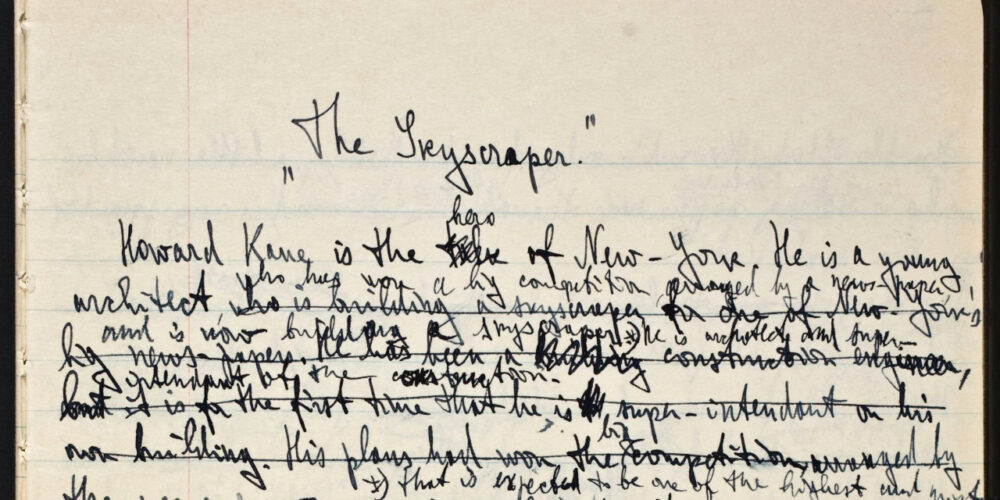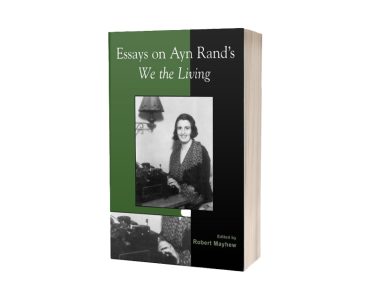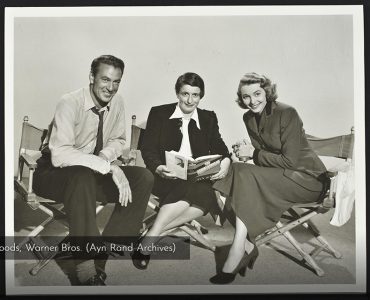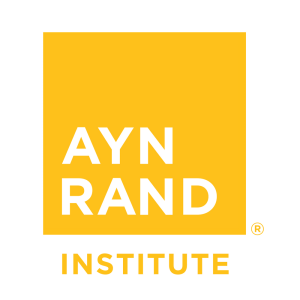Recent comments by film director Zack Snyder have drawn attention to Ayn Rand’s bestselling novel, The Fountainhead. During a podcast with Joe Rogan, Snyder said that Rand wrote the novel as a “direct response” to her experience writing multiple versions of a screenplay about skyscrapers — a script that was eventually rendered “unrecognizable” because of “notes” by the studio. Archival materials housed in the Ayn Rand Archives reveal a different account of events.
In 1927, while employed as a junior screenwriter for filmmaker Cecil B. DeMille, Ayn Rand was tasked with adapting a story idea by Dudley Murphy to the big screen. Titled “The Skyscraper,” the original narrative (in Rand’s words) consisted of a rivalry between “two rough and tough construction workers who were in love with the same girl.”1 Rand’s version focused instead on a young architect who is commissioned to construct a building — described as “one of the highest and most unusual in the city.”2
The treatment has some similarities to aspects of The Fountainhead. The main character, Howard Kane, faces criminal charges and intense public scrutiny. Kane’s love interest is engaged to a jealous rival. The story ends with Kane victorious, standing atop his completed building, “his head thrown far back — just a man looking at the sky.”3
Despite Snyder’s claims, there is no documented evidence that Rand submitted multiple versions of a screenplay that was mutilated by studio notes. Rather, Rand submitted a story treatment that left her unsatisfied. Years later, in biographical interviews housed in the Archives, Rand stated that writing the story treatment for “The Skyscraper” was a tremendous challenge. “I had a miserable time with that story,” reflected Rand. “I could not devise any kind of plot to satisfy myself; I tried in every way. I finally did devise something, but it wasn’t too good.”4 'Despite Snyder’s claims, there is no documented evidence that Rand submitted multiple versions of a screenplay that was mutilated by studio notes.' Share on X
DeMille ultimately produced a film based on Murphy’s original version of the story rather than Rand’s treatment. She would later describe the subsequent film, Skyscraper, released in 1928 and starring William Boyd, as “the lousiest homey picture.”5
There is no evidence that this experience served as inspiration for The Fountainhead, as Snyder claims, and Rand would not write her first notes for the novel until years later in December of 1935.6 However, Rand’s experience in Hollywood did serve as important context for the theme of The Fountainhead. Specifically, a conversation with an ambitious executive assistant at RKO Studio served as “the birth of The Fountainhead as such.”7 When Rand asked the assistant what she wanted out of life, she replied: “If nobody had an automobile, then I would want to have one automobile. If some people have one, then I want to have two.” For Rand — an independent valuer who had spent many years observing people and asking, “What makes them tick?” — this conversation came “like a dramatic revelation.” She had grasped the concept of a “second-hander,” a type of person who is motivated primarily by the opinions of others, and “Second-Hand Lives” became her working title for The Fountainhead.8
Rand’s work on “The Skyscraper” story treatment factored into her personal life in a meaningful way. While researching the project, Rand scheduled an appointment with the superintendent at a construction site in Hollywood.9 After the appointment was rescheduled by an hour, Rand decided to wait at the nearby Hollywood Branch of the Los Angeles Public Library. It was there that she happened to see Frank O’Connor again, whom she had met on a film set six months earlier. During that first encounter, Rand did not get Frank’s name, nor did she have any means of contacting him. This chance reunion led to the couple’s first date, which eventually blossomed into a marriage that lasted for the next fifty years. As Rand would later recount when discussing “The Skyscraper,” “It’s because of that story that I found Frank again.”10
Do you have a comment or question?
Endnotes
- Biographical interviews (Ayn Rand Archives).
- “DeMille-era notebook,” Ayn Rand Archives, 166_03B_001_023.
- “DeMille-era notebook,” Ayn Rand Archives, 166_03B_001_034.
- Biographical interviews (Ayn Rand Archives).
- Biographical interviews (Ayn Rand Archives).
- “‘Second-Hand Lives’ notebook,” Ayn Rand Archives, 167_01B_001_001.
- Biographical interviews (Ayn Rand Archives).
- ARI shared a portion of the audio from Rand’s biographical recollections during a members-only Roundtable event. The audio featured Rand’s comments on how The Fountainhead became a reality. For more on the novel’s development, readers are invited to view the online exhibit, Blueprints for The Fountainhead, which includes over 200 handwritten pages of planning notes for the novel, as well as their transcripts.
- Biographical interviews (Ayn Rand Archives). For greater detail on the locations involved in this encounter, readers should consult Michael S. Berliner and Anu Seppala’s book, Russia to America: A Guide to Ayn Rand Homes and Sites (United States: Ayn Rand Institute Press, 2023), 47–48.
- Biographical interviews (Ayn Rand Archives). For a further discussion on Snyder’s comments about The Fountainhead, readers should watch this episode of New Ideal Live with Elan Journo. Those interested in the published version of Rand’s story treatment for “The Skyscraper” may consult chapter 1 of Journals of Ayn Rand.







